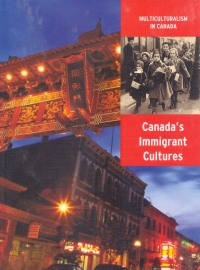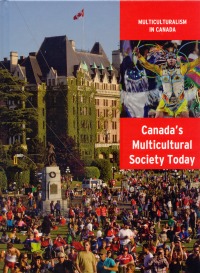| ________________
CM . . .
. Volume XVIII Number 27. . . .March 16, 2012 
 |
Canada’s Immigrant Cultures. (Multiculturalism in Canada).
Barbara Samuels & Cheryl Craig.
Calgary, AB: Weigl, 2012.
32 pp., pbk. & hc., $10.95 (pbk.), $24.95 (hc.).
ISBN 978-1-77071-708-4 (pbk.), ISBN 978-1-77071-705-3 (hc.).
Subject Heading:
Immigrants History-Juvenile literature.
Grades 6-8 / Ages 11-13.
Review by Gail Hamilton.
*** /4
|
| |
|
 |
Canada’s Multicultural Society Today. (Multiculturalism in Canada).
Barbara Samuels & Cheryl Craig.
Calgary, AB: Weigl, 2012.
32 pp., pbk. & hc., $10.95 (pbk.), $24.95 (hc.).
ISBN 978-1-77071-709-1 (pbk.), ISBN 978-1-77071-706-0 (hc.).
Subject Heading:
Canada- Emegration and Immigration-Juvenile literature.
Grades 6-8 / Ages 11-13.
Review by Gail Hamilton.
*** /4
|
| |
|

excerpt:
Many organizations receive money from the federal government. When the government required them to start employment equity programs, some organizations introduced these programs just to avoid losing government money. Employment equity programs are still controversial. Some people claim that they are a form of “reverse discrimination”. These critics mean that, instead of making everyone equal, employment equity makes it more difficult for people not included in the special groups to find jobs. They worry that employers who are encouraged to hire more women, Aboriginal Peoples, people with disabilities, and visible minorities will overlook other qualified people who do not fit into any of these categories. (From Canada’s Multicultural Society Today.)
Providing plenty of food for thought and guaranteed to spark some interesting discussion, these two titles are part of the three-volume “Multiculturalism in Canada” series. Each of the titles consists of 15 chapters as well as a table of contents, a glossary and an index. In addition to the main body of the text, there are small “Think About It” boxes which pose questions, such as “If Canada’s birth rate continues to decline, should the country increase the number of immigrants admitted each year?” There are also “Making Choices” boxes which require readers to examine both sides of an issue and justify their decisions. For example, readers are asked to decide whether Canadian society should be a melting pot or a mosaic. A couple of case studies on specific topics are included in each title as are five viewpoints on issues related to the text, one example being whether or not economic immigration should have precedence over other types of immigration. At the back of the books, there are five activities, many of them research-based, for readers to try, a “skillbuilders” graph or chart to interpret, and a short quiz. Illustrations, all of them suitably labeled, include colour photos, drawings, paintings, charts and graphs. (There is only one minor flaw in the illustrations: on page nine of the first title, there is a photograph of Scottish bagpipers marching in a parade, yet the text beneath the photo describes the strong Irish influence in Montreal, “which hosts one of the oldest Saint Patrick’s Day parades in North America”. Although the bagpipers could, in fact, be marching in that parade, it might have been better to include a photo of Irish people or a St. Patrick’s Day-themed float.)
Canada’s Immigrant Cultures focuses primarily on the history of immigration in Canada as well as the nation’s policies on immigration. Today, it is estimated that 20 per cent of Canada’s people were born in other countries. Over the course of history, there have been a number of reasons why immigrants have fled their homelands, these reasons ranging from war, religious persecution and famine to the promise of free land in Canada and hope for a better life. Prior to Confederation, the people who came to Canada were mostly from Europe and the United States (for example, the United Empire Loyalists). With the construction of the Canadian Pacific Railway, the government wanted to promote the development and settlement of the West and offered free land, which, by Confederation, was in short supply in eastern Canada. Restrictions were later tightened on entrance to Canada of some minority groups, such as the Chinese, black Africans, and Jewish refugees. After World War II, Canada needed to change its immigration policy. To that end, Prime Minister William Lyon Mackenzie King allowed British and American subjects, relatives of Canadian citizens, people who had skills that were in demand in Canada, some refugees, displaced persons and former Polish soldiers into the country. This was also the beginning of the sponsorship system which has seen a few changes over the years. Today, Canada accepts 10,000-12,000 new refugees each year. In 1967, the point system was introduced, whereby people who met specific criteria- some examples include age, education, occupation, preferred area of settlement, knowledge of French or English, and work skills- were allowed to immigrate. By 1986, some immigration rules were relaxed, and business people with a personal worth of $500,000 were welcomed (that value has since risen). These changes attracted wealthy people from Hong Kong, Taiwan, Britain and the U.S. The current immigration law, the Immigration and Refugee Protection Act, was passed in 2001. It recognizes six categories of immigrants, some of which are skilled workers and professionals, business immigrants, and families of Canadian citizens. Recently, the largest number of immigrants has come from South Korea, China, India, the Philippines, Pakistan and the United States. Most of them choose to live in Ontario and/or in large cities. Finally, the book discusses the main reasons why Canada encourages new immigrants to settle here. These include economic growth, immigrants’ contributions to the tax base and increasing population. One of the book’s case studies highlights the Potato Famine in Ireland, while the other explains the lifestyle of the Hutterites who practice segregation. Two timelines are also provided, one covering the years 1605-1939, and the second, from 1945-2011. (One questionable- and, perhaps, slightly offensive- term in one of the glossary definitions is “non-white”. Perhaps the glossary entry, “visible minority”, should have been defined instead as “a person of colour who is neither Aboriginal nor Caucasian in origin”.)
It is estimated that, by 2031, nearly one-third of all Canadians will belong to a visible minority group. Even today, more than 40% of the people living in the Metro Toronto area are foreign-born. Canada’s Multicultural Society Today explains the difference between a melting pot and a mosaic and discusses the advantages and disadvantages of each. This title goes on to show that Canada is composed of communities within communities and that a person can belong to several at the same time. An example is that a child can be part of his school community, his neighbourhood, his community club and his religious group, all within his city, province and country. Each community has its festivals, celebrating its traditions- for instance, the Calgary Stampede and the Lucy Maud Montgomery Festival in Cavendish, which are specific to their respective cities, and Chinese New Year and Hanukkah, which are specific to cultural and religious communities throughout the country. Multiculturalism is compared to a large symphony orchestra in which the various instruments look and sound different, but when masterfully played together as a group, they become one entity. This analogy will help readers to understand that, although there is great diversity between different communities of people, everyone has an important part to play, and when all members of a community work together and cooperate, wonderful things can happen. One case study in this title discusses Calgary’s boom period, from 1999-2009, when its population grew by one-third. With so many young adults moving to that city, its average age is well below the nation’s average. The second case study highlights the Dene people’s declaration outlining their wish to be regarded as a distinct people and as a nation within Canada. Nunavut’s establishment in 1999, giving the Inuit people more control over their land and their destiny, is another example of self-government or “self-determination”. Through surveys, most Canadians indicate that they believe that cultural diversity enriches a country, but some do not share this viewpoint. Examples of racism and how it develops are presented in this title along with a moving account of one girl’s personal experience, not as a victim of racism, but as a witness who observes an act of racism and does nothing about it. Other topics in this title include the Employment Equity Act, first passed in 1986 and revised in 1995, which ensures that jobs are open to all qualified people, and changing Aboriginal communities.
Both of these titles would be very useful to a classroom teacher, not only for background information, but also for some good ideas on research projects and class discussions.
Recommended.
Gail Hamilton is a former teacher-librarian in Winnipeg, MB.

To comment
on this title or this review, send mail to cm@umanitoba.ca.
Copyright © the Manitoba Library Association. Reproduction for personal
use is permitted only if this copyright notice is maintained. Any
other reproduction is prohibited without permission.
NEXT REVIEW |
TABLE OF CONTENTS FOR THIS ISSUE
- March 16, 2012.
AUTHORS |
TITLES |
MEDIA REVIEWS |
PROFILES |
BACK ISSUES |
SEARCH |
CMARCHIVE |
HOME |

